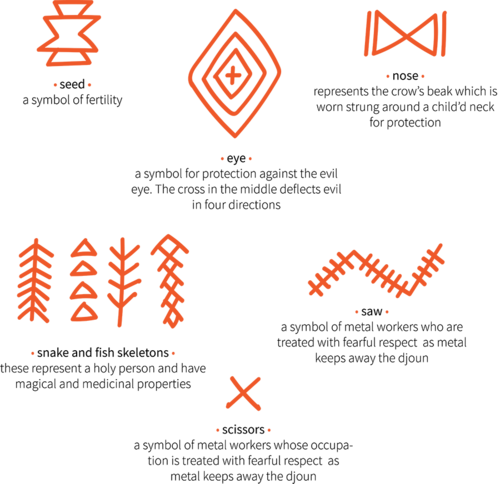Reading Your Carpet: The Symbolism of Moroccan Rugs
Ever wonder what those abstract and sometimes ineligible pictures mean on Moroccan carpets? Throughout the history of Moroccan weavings and textiles, there has been a reoccurring collection of symbols, motifs, and tattoos used by artisans in their work.
Weaving motifs, patterns, and designs in Moroccan textiles act on different levels. Some identify a family or tribe through tattoos or wasms (Arabic for tribal identity marks), while others ward off evil and bring good luck. These symbols and motifs includes magic numbers, magic squares, verses of the Koran, Arabic script, geometric figures, triangles, squares, crosses, eight-pointed stars, Star of Davids, spirals, circles, diamonds, floral and other vegetable motifs, abstract and representational animal designs, hands, eyes, and a variety of tattoos. Each one of these symbols holds different meanings depending on who you ask. But we've compiled some general explanations for common symbols found in Berber carpets.
Two of the most frequently used motifs are the hand and the eye, used to ward off the evil eye and the djoun, an evil spirit. The evil eye, feared throughout the Mediterranean world, is a power held by certain people whose stares and glances are thought to bring bad luck to those upon whom they fall.
The hand, called khamsa - a symbol of human creativity, power, and dominance - symbolizes the number five, whose magical properties are believed to protect the individual from evil forces. The eye motif can be depicted abstractly or realistically. It can appear as a triangle symbolizing one eye, or a row of triangles representing a pair. These designs posses magical properties against evil and are thought to protect people, animals, objects, or the textile itself.
Representational designs of motifs such as scissors, weaving combs, and knives are also believed to counter the effect of the evil eye.
Animal symbols and motifs frequently appear in textiles. They are created simply and elegantly. Motifs of scorpions or jackals serve as protectors, while fish represent water, rain, fertility of the earth, and prosperity. The bird, cited in the Koran as a messenger between heaven and earth, represents destiny. Lizards are seen as seekers of the sun and represent human souls searching for light. Snakes are a symbol of fertility and are thought to have healing powers. Turtle motifs represent saints and provide protection against evil forces.


